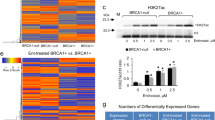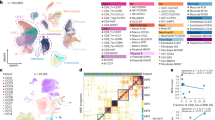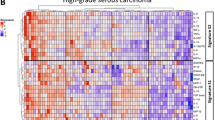Abstract
Suppressor of cytokine signaling (SOCS) proteins have emerged as critical attenuators of cytokine-mediated processes, suggesting a role in the suppression of tumorigenesis. In the ovary and mammary gland, cytokines such as prolactin and IL-6 are important regulators of growth and differentiation. We have investigated whether silencing or inactivation of SOCS genes occurs in ovarian and breast carcinomas. The SOCS1 and SOCS2 CpG islands were found to be hypermethylated in 23 and 14% of primary ovarian cancers, respectively, whereas only SOCS1 was methylated in breast cancers (9%). Methylation of these genes did not occur in normal tissues. No correlation was apparent between methylation and loss of heterozygosity, and no somatic mutations were found in a large panel of carcinomas. Aberrant methylation of these SOCS genes correlated with transcriptional silencing in ovarian and breast cancer cell lines, since expression was induced by the demethylating agent 5-azadeoxycytidine. SOCS3 was not hypermethylated in either cancer type. Consistent with this data, SOCS1 and SOCS2 but not SOCS3 suppressed the growth of ovarian and breast cancer cells. Hypermethylation and silencing of specific SOCS genes in the ovary, and to a lesser extent in breast, may augment cytokine responsiveness in these tissues, thereby contributing to oncogenesis.
This is a preview of subscription content, access via your institution
Access options
Subscribe to this journal
Receive 50 print issues and online access
$259.00 per year
only $5.18 per issue
Buy this article
- Purchase on Springer Link
- Instant access to full article PDF
Prices may be subject to local taxes which are calculated during checkout




Similar content being viewed by others
References
Brender C, Nielsen M, Kaltoft K, Mikkelsen G, Zhang Q, Wasik M, Billestrup N and Odum N . (2001). Blood, 97, 1056–1062.
Catteau A and Morris JR . (2002). Semin. Cancer Biol., 12, 359–371.
Chaubert P, Bautista D and Benhattar J . (1993). Biotechniques, 15, 586.
Chen CY, Tsay W, Tang JL, Shen HL, Lin SW, Huang SY, Yao M, Chen YC, Shen MC, Wang CH and Tien HF . (2003). Genes Chromosomes Cancer, 37, 300–305.
Dobrovic A, Bianco T, Tan LW, Sanders T and Hussey D . (2002). Methods, 27, 134–138.
Endo TA, Masuhara M, Yokouchi M, Suzuki R, Sakamoto H, Mitsui K, Matsumoto A, Tanimura S, Ohtsubo M, Misawa H, Miyazaki T, Leonor N, Taniguchi T, Fujita T, Kanakura Y, Komiya S and Yoshimura A . (1997). Nature, 387, 921–924.
Fukushima N, Sato N, Sahin F, Su GH, Hruban RH and Goggins M . (2003). Br. J. Cancer, 89, 338–343.
Galm O, Yoshikawa H, Esteller M, Osieka R and Herman JG . (2003). Blood, 101, 2784–2788.
Graff JR, Herman JG, Lapidus RG, Chopra H, Xu R, Jarrard DF, Isaacs WB, Pitha PM, Davidson NE and Baylin SB . (1995). Cancer Res., 55, 5195–5199.
Grosdemouge I, Bachelot A, Lucas A, Baran N, Kelly PA and Binart N . (2003). Reprod. Biol. Endocrinol., 1, 12.
Guilleret I, Yan P, Grange F, Braunschweig R, Bosman FT and Benhattar J . (2002). Int. J. Cancer, 101, 335–341.
He B, You L, Uematsu K, Zang K, Xu Z, Lee AY, Costello JF, McCormick F and Jablons DM . (2003). Proc. Natl. Acad. Sci. USA, 100, 14133–14138.
Helman D, Sandowski Y, Cohen Y, Matsumoto A, Yoshimura A, Merchav S and Gertler A . (1998). FEBS Lett., 441, 287–291.
Herman JG, Jen J, Merlo A and Baylin SB . (1996). Cancer Res., 56, 722–727.
Hilton DJ, Richardson RT, Alexander WS, Viney EM, Willson TA, Sprigg NS, Starr R, Nicholson SE, Metcalf D and Nicola NA . (1998). Proc. Natl. Acad. Sci. USA, 95, 114–119.
Horseman ND, Zhao W, Montecino-Rodriguez E, Tanaka M, Nakashima K, Engle SJ, Smith F, Markoff E and Dorshkind K . (1997). EMBO J., 16, 6926–6935.
Kamizono S, Hanada T, Yasukawa H, Minoguchi S, Kato R, Minoguchi M, Hattori K, Hatakeyama S, Yada M, Morita S, Kitamura T, Kato H, Nakayama K and Yoshimura A . (2001). J. Biol. Chem., 276, 12530–12538.
Kaulsay KK, Mertani HC, Tornell J, Morel G, Lee KO and Lobie PE . (1999). Exp. Cell Res., 250, 35–50.
Lindeman GJ, Wittlin S, Lada H, Naylor MJ, Santamaria M, Zhang JG, Starr R, Hilton DJ, Alexander WS, Ormandy CJ and Visvader J . (2001). Genes Dev., 15, 1631–1636.
Machelon V, Nome F and Salesse R . (1994). Cell Mol. Biol. (Noisy-le-grand), 40, 373–380.
Naka T, Narazaki M, Hirata M, Matsumoto T, Minamoto S, Aono A, Nishimoto N, Kajita T, Taga T, Yoshizaki K, Akira S and Kishimoto T . (1997). Nature, 387, 924–929.
Narazaki M, Fujimoto M, Matsumoto T, Morita Y, Saito H, Kajita T, Yoshizaki K, Naka T and Kishimoto T . (1998). Proc. Natl. Acad. Sci. USA, 95, 13130–13134.
Nash MA, Ferrandina G, Gordinier M, Loercher A and Freedman RS . (1999). Endocr. Relat. Cancer, 6, 93–107.
Ormandy CJ, Camus A, Barra J, Damotte D, Lucas B, Buteau H, Edery M, Brousse N, Babinet C, Binart N and Kelly PA . (1997). Genes Dev., 11, 167–178.
Ottaviano YL, Issa JP, Parl FF, Smith HS, Baylin SB and Davidson NE . (1994). Cancer Res., 54, 2552–2555.
Pezet A, Favre H, Kelly PA and Edery M . (1999). J. Biol. Chem., 274, 24497–24502.
Raccurt M, Tam SP, Lau P, Mertani HC, Lambert A, Garcia-Caballero T, Li H, Brown RJ, McGuckin MA, Morel G and Waters MJ . (2003). Br. J. Cancer, 89, 524–532.
Ram PA and Waxman DJ . (2000). J. Biol. Chem., 275, 39487–39496.
Rottapel R, Ilangumaran S, Neale C, La Rose J, Ho JM, Nguyen MH, Barber D, Dubreuil P and de Sepulveda P . (2002). Oncogene, 21, 4351–4362.
Sakai I, Takeuchi K, Yamauchi H, Narumi H and Fujita S . (2002). Blood, 100, 2926–2931.
Silberstein GB and Daniel CW . (1987). J. Dairy Sci., 70, 1981–1990.
Starr R, Willson TA, Viney EM, Murray LJ, Rayner JR, Jenkins BJ, Gonda TJ, Alexander WS, Metcalf D, Nicola NA and Hilton DJ . (1997). Nature, 387, 917–921.
Tam SP, Lau P, Djiane J, Hilton DJ and Waters MJ . (2001). Endocrinology, 142, 5015–5026.
Tomic S, Chughtai N and Ali S . (1999). Mol. Cell. Endocrinol., 158, 45–54.
Xiao W and Oefner PJ . (2001). Hum. Mutat., 17, 439–474.
Yasukawa H, Misawa H, Sakamoto H, Masuhara M, Sasaki A, Wakioka T, Ohtsuka S, Imaizumi T, Matsuda T, Ihle JN and Yoshimura A . (1999). EMBO J., 18, 1309–1320.
Yoshikawa H, Matsubara K, Qian GS, Jackson P, Groopman JD, Manning JE, Harris CC and Herman JG . (2001). Nat. Genet., 28, 29–35.
Zhao L, Melenhorst JJ and Hennighausen L . (2002). Mol. Endocrinol., 16, 2902–2912.
Acknowledgements
We thank A Partanen for expert assistance with cryosectioning. We are grateful to N Jonas for help with cell culture, J Zhang for SOCS3 antibody, R Daly for providing MCF-7 EcoR cells, N Hayward for providing tumor samples, and I Haviv for ovarian cell cDNA. This work was supported by the Victorian Breast Cancer Research Consortium and the Bone Marrow Research Laboratories.
Author information
Authors and Affiliations
Corresponding author
Rights and permissions
About this article
Cite this article
Sutherland, K., Lindeman, G., Choong, D. et al. Differential hypermethylation of SOCS genes in ovarian and breast carcinomas. Oncogene 23, 7726–7733 (2004). https://doi.org/10.1038/sj.onc.1207787
Received:
Revised:
Accepted:
Published:
Issue Date:
DOI: https://doi.org/10.1038/sj.onc.1207787
Keywords
This article is cited by
-
Alterations of SOCS1 and SOCS3 transcript levels, but not promoter methylation levels in subcutaneous adipose tissues in obese women
BMC Endocrine Disorders (2023)
-
Semantic clustering analysis of E3-ubiquitin ligases in gastrointestinal tract defines genes ontology clusters with tissue expression patterns
BMC Gastroenterology (2022)
-
SOCS3 gene silencing does not occur through methylation and mutations in gastric cancer
Human Cell (2022)
-
Comprehensive analysis of suppressor of cytokine signaling proteins in human breast Cancer
BMC Cancer (2021)
-
The tyrosine phosphatase SHP2 increases robustness and information transfer within IL-6-induced JAK/STAT signalling
Cell Communication and Signaling (2021)



